

Great Tires at a Great Price!
Here at Busam Nissan we have great tires at a great price! We have partnered with Tirerack.com to help deliver you great deals! Tires are one of the most important part, if not THE most important part, on a car. Your tires are the first and only thing to touch the road an having good tires can make the difference from sliding off the road or gripping around a tight corner. To learn more about tires today click the plus signs below or call our service department!
Wheel alignment & balance
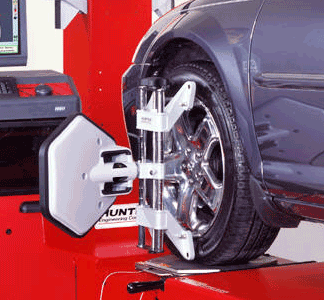 February 14, 2016, from
February 14, 2016, from//garysautomotiveservice.com/blog/wp-content/uploads/2011/02/wheel-alignment-img.png
WHY IS WHEEL ALIGNMENT IMPORTANT?
Wheel alignment, sometimes referred to as breaking or tracking, is part of standard automobile maintenance that consists of adjusting the angles of the wheels so that they are set to the car maker's specification. The purpose of these adjustments is to reduce tire wear, and to ensure that vehicle travel is straight and true (without "pulling" to one side). Alignment angles can also be altered beyond the maker's specifications to obtain a specific handling characteristic. Motorsport and off-road applications may call for angles to be adjusted well beyond "normal" for a variety of reasons.
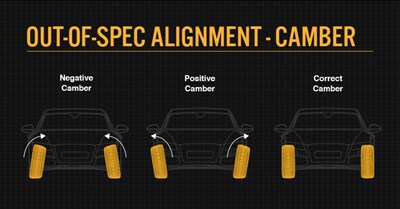
Retrieved
February 10, 2016, from
//www.bridgestonetire.com/tread-and-trend/drivers-ed/tire-tread-wear-causes
What is camber?
The most widely discussed and controversial of the three elements is camber. Camber angle is the measure in degrees of the difference between the wheels vertical alignment perpendicular to the surface. If a wheel is perfectly perpendicular to the surface, its camber would be 0 degrees. Camber is described as negative when the top of the tires begin to tilt inward towards the fender wells. Consequently, when the top of the tires begin to tilt away from the vehicle it is considered positive.
Negative camber is becoming increasingly more popular because of its visual appeal. The real advantages to negative camber are seen in the handling characteristics. An aggressive driver will enjoy the benefits of increased grip during heavy cornering with negative camber. During straight acceleration however, negative camber will reduce the contact surface between the tires and road surface.
Regrettably, negative camber generates what is referred to as camber thrust. When both tires are angled negatively they push against each other, which is fine as long as both tires are in contact with the road surface. When one tire loses grip, the other tire no longer has an opposing force being applied to it and as a result the vehicle is thrust towards the wheel with no traction.
Zero camber will result in more even tire wear over time, but may rob performance during cornering. Ultimately, optimal camber will depend upon your driving style and conditions the vehicle is being driven in.
What is caster?

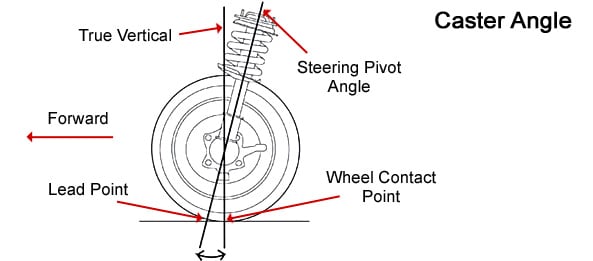
Retrieved
February 14, 2016, from
//www.steeda.com/blog/wp-content/uploads/2012/08/caster-diagram1.jpg
February 14, 2016, from
//www.steeda.com/blog/wp-content/uploads/2012/08/caster-diagram1.jpg
The caster angle or castor angle is the angular displacement from the vertical axis of the suspension of a steered wheel in a car, motorcycle, bicycle or other vehicle, measured in the longitudinal direction. It is the angle between the pivot line (in a car an imaginary line that runs through the center of the upper ball joint to the center of the lower ball joint) and vertical. Car racers sometimes adjust caster angle to optimize their car's handling characteristics in particular driving situations.
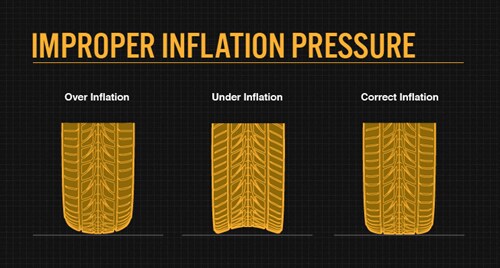
February 10, 2016, from
//www.bridgestonetire.com/tread-and-trend/drivers-ed/tire-tread-wear-causes
What happens if a tire is underinflated?
Premature or irregular wear
Poor handling
Reduced fuel economy
Overheating, which could lead to a blowout
What happens if a tire is overinflated?
Unusual wear
Poor handling
Rough ride
Greater risk of damage from road hazards
HOW TO CHECK TIRE PRESSURE

February 14, 2016, from
//www.bridgestonetire.com/content/dam/bst/research/checking-tire-pressure-steps.png

February 14, 2016, from
//www.bridgestonetire.com/content/dam/bst/research/checking-tire-pressure-steps.png
1. Purchase a trusted tire pressure gauge.
2. Check your tires "cold" - before you've driven or at least three hours after you've driven.
3. Insert tire pressure gauge into the valve stem on your tire. (If you are using a digital tire gauge like the one pictured, the gauge should begin
reading the air pressure immediately. Refer to your air pressure gauge owners manual for correct usage instructions. If using a "pencil" style
tire gauge, the gauge will "pop" out and show a measured number. When you hear a "pssst" sound, that's air escaping the tire. The escaping
air shouldn't affect pressure substantially, unless you hold down the air pressure gauge too long.)
4. Compare the measured psi to the psi found on the sticker inside the driver's door of your vehicle or in owner's manual. DO NOT compare to
the psi on your tire's sidewall.
5. If your psi is above the number, let air out until it matches. If below, add air (or have a Michelin retailer help you) until it reaches the proper number.
What is a tire pressure monitoring system?
A tire-pressure monitoring system (TPMS) is an electronic system designed to monitor the air pressure inside the pneumatic tires on various types of vehicles. TPMS report real-time tire-pressure information to the driver of the vehicle, either via a gauge, a pictogram display, or a simple low-pressure warning light. TPMS can be divided into two different types - direct (dTPMS) and indirect (iTPMS). TPMS are provided both at an OEM (factory) level as well as an aftermarket solution. The target of a TPMS is avoiding traffic accidents, poor fuel economy, and increased tire wear due to under-inflated tires through early recognition of a hazardous state of the tires.
How do you know that air pressure is low or whether the TPMS has malfunctioned?
2. Check your tires "cold" - before you've driven or at least three hours after you've driven.
3. Insert tire pressure gauge into the valve stem on your tire. (If you are using a digital tire gauge like the one pictured, the gauge should begin
reading the air pressure immediately. Refer to your air pressure gauge owners manual for correct usage instructions. If using a "pencil" style
tire gauge, the gauge will "pop" out and show a measured number. When you hear a "pssst" sound, that's air escaping the tire. The escaping
air shouldn't affect pressure substantially, unless you hold down the air pressure gauge too long.)
4. Compare the measured psi to the psi found on the sticker inside the driver's door of your vehicle or in owner's manual. DO NOT compare to
the psi on your tire's sidewall.
5. If your psi is above the number, let air out until it matches. If below, add air (or have a Michelin retailer help you) until it reaches the proper number.
What is a tire pressure monitoring system?
How do you know that air pressure is low or whether the TPMS has malfunctioned?
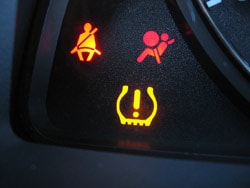
Retrieved
February 14, 2016, from
//edmonton.yatbo.ca/pics/ad_img/carsvehicles/other/a415961.jpg
If your tire pressure is low or TPMS system has malfunctioned the light for the TPMS system should be a solid color. If this happens make sure to come into one of our dealerships and we'll fix the issue right away!
Tire Rotation

Retrieved
February 14, 2016, from
//www.discounttiredirect.com/images/tireRotation.gif
Tire Rotation

Retrieved
February 14, 2016, from
//www.discounttiredirect.com/images/tireRotation.gif
Why is tire rotation important?
Rotating your tires as part of your regularly scheduled vehicle maintenance has many benefits. It helps to maintain an even amount of treadwear on all 4 tires. That prolongs the life of your tires, leads to improved gas mileage and a smoother more comfortable ride. Regularly rotating your tires can also prolong the life of your vehicle's suspension components by reducing vibrations. Since you need to remove the wheels to rotate your tires, you get the opportunity to look over the undercarriage components and catch any problems in the very early stages which can save you money down the road. Also, many tire manufacturers require regular tire rotation in order to keep the mileage warranty valid. A good rule of thumb is to rotate your tires at the same intervals you get your oil changed whether your tires show uneven wear signs or not. While this is a good recommendation, you should always follow the guidelines in your vehicle's owner manual for timing as well as the best rotation pattern for your vehicle and type of tires.
Tire rotation patterns
All tire rotation paterns are listed above!
Tire Wear
What causes wear?
As tires are used, it is normal for the tread to gradually become shallower and overall tire performance to change. In addition, irregular tread wear may occur for a variety of reasons that may lead you to have to replace a tire sooner rather than later. Regularly checking the tread depth and wear condition of each tire on your vehicle will not only let you know when it is time to replace a tire, it can also help you detect other needed maintenance and get the most value out of your vehicle and tires.
Rotating your tires as part of your regularly scheduled vehicle maintenance has many benefits. It helps to maintain an even amount of treadwear on all 4 tires. That prolongs the life of your tires, leads to improved gas mileage and a smoother more comfortable ride. Regularly rotating your tires can also prolong the life of your vehicle's suspension components by reducing vibrations. Since you need to remove the wheels to rotate your tires, you get the opportunity to look over the undercarriage components and catch any problems in the very early stages which can save you money down the road. Also, many tire manufacturers require regular tire rotation in order to keep the mileage warranty valid. A good rule of thumb is to rotate your tires at the same intervals you get your oil changed whether your tires show uneven wear signs or not. While this is a good recommendation, you should always follow the guidelines in your vehicle's owner manual for timing as well as the best rotation pattern for your vehicle and type of tires.
Tire rotation patterns
All tire rotation paterns are listed above!
Tire Wear
What causes wear?
As tires are used, it is normal for the tread to gradually become shallower and overall tire performance to change. In addition, irregular tread wear may occur for a variety of reasons that may lead you to have to replace a tire sooner rather than later. Regularly checking the tread depth and wear condition of each tire on your vehicle will not only let you know when it is time to replace a tire, it can also help you detect other needed maintenance and get the most value out of your vehicle and tires.

Retrieved
February 14, 2016, from
//www.speedtechequipment.com/wp-content/uploads/2014/08/interpreting-tread-wear-patterns-12.jpg
Toe Tire Wear
The amount of "toe" a vehicle has refers to the angles at which the tires are aligned. If a vehicle's tires are "toe-in" (also known as positive toe), the front of each tire is angled inward. If a vehicle's tires are "toe-out" (also known as negative toe), the front of each tire is angled outward. It is actually normal for a vehicle's tires to have a tiny amount of toe. The amount of toe can increase due to wheels being out of alignment, and that is when it can cause your tires to wear prematurely. A tire with toe wear will typically be worn on the inside shoulder of the tire. That is, it will have a smooth strip of wear around it on the side that is facing the wheel well. Having your alignment checked and adjusted regularly can help you to avoid toe wear.
Camber Tire Wear
"Camber" refers to how a tire tilts. If a tire has negative camber, it means that the top of the tire is tilted towards the vehicle. If a tire has positive camber, it means that the top of the tire is tilted away from the vehicle. Tires on a everyday car (i.e. a vehicle not used for racing) should have little to no camber at all; when you look at the tires from the front or back of the vehicle, they should be perfectly vertical. Camber wear occurs when a tire has positive or negative camber. With positive camber, the outer shoulder of the tire will be a smooth, narrow strip of wear while the rest of the tire will look fine. With negative camber, the inner shoulder of the tire will have that smooth, narrow strip of wear. Camber wear can be caused by improper tire pressure, misaligned wheels, or worn suspension components. If you spot camber wear and the tires are properly inflated, having your vehicle looked at by a professional is recommended.
Center Tire Wear
Center wear is exactly what it sounds like: the tire is worn down in the center. There will be tread on the sides of the tire and a smooth, narrow strip of wear around the center of it. This is mostly caused by tires that are overinflated. When a tire is overinflated, the tire, in essence, bulges out more in the center. The tire then rides mostly on that bulge and that bulge wears faster than the sides of the tire. Keeping your tires properly inflated can help you to avoid center wear. If you aren't sure what the proper tire pressure is for you, consult your vehicle's owner's manual or look inside the driver's doorjamb of the car where it should be listed.
Cupping Tire Wear
There are coil springs in between the frame and wheels of your vehicle. When you drive over a bump, the car bounces on the springs . Shocks and/or struts keep the vehicle from bouncing continually, keeping the tires connected with the road. When the shocks and/or struts are worn out, the car continues to bounce, causing the tires to momentarily leave the road surface. Besides being really unsafe, this bouncing can cause pieces of rubber to be gouged out of the tires, which is referred to as cupping or scalloping. Cupped tires will often have random smooth patches all over them. These smooth patches are holes left by the missing rubber that have been smoothed over by driving on them. Unbalanced tires or wheels can also cause cupping.
Shoulder Tire Wear
This is the exact opposite of center wear. Instead of a smooth, worn strip down the center of the tire, the sides, also known as the shoulders, of the tire will be worn. So the tire will have a smooth, narrow strip of wear on one shoulder, a strip of normal-looking tread around the center, then another smooth, narrow strip of wear on the other shoulder. Under-inflation is shoulder wear's most common culprit. When you drive on an underinflated tire, more of the tire contacts the road, and this causes the shoulders of the tire to wear prematurely. Similar to center wear, you can steer clear of shoulder wear by making sure that your tires are properly inflated. Helpful tip: your tires can lose 1 to 2 lbs. of air pressure for every 10° the temperature drops outside so when it gets cold, check your tire pressure to make sure your tires are properly inflated.
The amount of "toe" a vehicle has refers to the angles at which the tires are aligned. If a vehicle's tires are "toe-in" (also known as positive toe), the front of each tire is angled inward. If a vehicle's tires are "toe-out" (also known as negative toe), the front of each tire is angled outward. It is actually normal for a vehicle's tires to have a tiny amount of toe. The amount of toe can increase due to wheels being out of alignment, and that is when it can cause your tires to wear prematurely. A tire with toe wear will typically be worn on the inside shoulder of the tire. That is, it will have a smooth strip of wear around it on the side that is facing the wheel well. Having your alignment checked and adjusted regularly can help you to avoid toe wear.
Camber Tire Wear
"Camber" refers to how a tire tilts. If a tire has negative camber, it means that the top of the tire is tilted towards the vehicle. If a tire has positive camber, it means that the top of the tire is tilted away from the vehicle. Tires on a everyday car (i.e. a vehicle not used for racing) should have little to no camber at all; when you look at the tires from the front or back of the vehicle, they should be perfectly vertical. Camber wear occurs when a tire has positive or negative camber. With positive camber, the outer shoulder of the tire will be a smooth, narrow strip of wear while the rest of the tire will look fine. With negative camber, the inner shoulder of the tire will have that smooth, narrow strip of wear. Camber wear can be caused by improper tire pressure, misaligned wheels, or worn suspension components. If you spot camber wear and the tires are properly inflated, having your vehicle looked at by a professional is recommended.
Center Tire Wear
Center wear is exactly what it sounds like: the tire is worn down in the center. There will be tread on the sides of the tire and a smooth, narrow strip of wear around the center of it. This is mostly caused by tires that are overinflated. When a tire is overinflated, the tire, in essence, bulges out more in the center. The tire then rides mostly on that bulge and that bulge wears faster than the sides of the tire. Keeping your tires properly inflated can help you to avoid center wear. If you aren't sure what the proper tire pressure is for you, consult your vehicle's owner's manual or look inside the driver's doorjamb of the car where it should be listed.
Cupping Tire Wear
There are coil springs in between the frame and wheels of your vehicle. When you drive over a bump, the car bounces on the springs . Shocks and/or struts keep the vehicle from bouncing continually, keeping the tires connected with the road. When the shocks and/or struts are worn out, the car continues to bounce, causing the tires to momentarily leave the road surface. Besides being really unsafe, this bouncing can cause pieces of rubber to be gouged out of the tires, which is referred to as cupping or scalloping. Cupped tires will often have random smooth patches all over them. These smooth patches are holes left by the missing rubber that have been smoothed over by driving on them. Unbalanced tires or wheels can also cause cupping.
Shoulder Tire Wear
This is the exact opposite of center wear. Instead of a smooth, worn strip down the center of the tire, the sides, also known as the shoulders, of the tire will be worn. So the tire will have a smooth, narrow strip of wear on one shoulder, a strip of normal-looking tread around the center, then another smooth, narrow strip of wear on the other shoulder. Under-inflation is shoulder wear's most common culprit. When you drive on an underinflated tire, more of the tire contacts the road, and this causes the shoulders of the tire to wear prematurely. Similar to center wear, you can steer clear of shoulder wear by making sure that your tires are properly inflated. Helpful tip: your tires can lose 1 to 2 lbs. of air pressure for every 10° the temperature drops outside so when it gets cold, check your tire pressure to make sure your tires are properly inflated.
Measuring Tread Depth

February 14, 2016, from
//www.tirebuyer.com/medias/sys_master/8829205184542/PennyQuarterTest-590x300.jpg

February 14, 2016, from
//www.tirebuyer.com/medias/sys_master/8829205184542/PennyQuarterTest-590x300.jpg
As you can see in the photo above there are different levels to measure how old your tires are with a penny. If the tread reaches Lincoln's nose you have practically brand new tires. If it reaches his hair line then your tires are worn. And finally if it only reaches his hair then you really need new tires! Also this test can be performed with a quarter.
When to replace tires
If you have read everything above and your tires fit any of the wear categories, then you probably need new tires! Come in and see us or call our service department about new tires
Know your Tires.
When to replace tires
If you have read everything above and your tires fit any of the wear categories, then you probably need new tires! Come in and see us or call our service department about new tires
Know your Tires.